As a drone visual observer for photography, you must maintain constant visual line of sight with the drone and scan for airborne hazards. Monitor weather conditions closely and communicate clearly with the pilot using established commands. Understand airspace restrictions and watch for ground-based obstacles. Assist with pre-flight checklists and track flight time and battery levels. Be aware of privacy concerns and avoid flying over sensitive areas. Identify safe landing spots and assess terrain for potential risks. Verify equipment functionality before takeoff. By following these key rules, you'll guarantee safer and more successful drone photography missions. There's much more to learn about being an effective visual observer.
Key Takeaways
- Maintain constant visual line of sight with the drone, tracking its movements and potential obstacles.
- Communicate clearly with the pilot using established commands and reliable communication systems.
- Continuously scan the airspace for hazards like other aircraft, birds, and changing weather conditions.
- Identify and assess safe landing areas throughout the flight, considering terrain and obstacles.
- Monitor flight time and battery levels, ensuring a safe return with at least 25% battery life remaining.
Maintain Visual Line of Sight
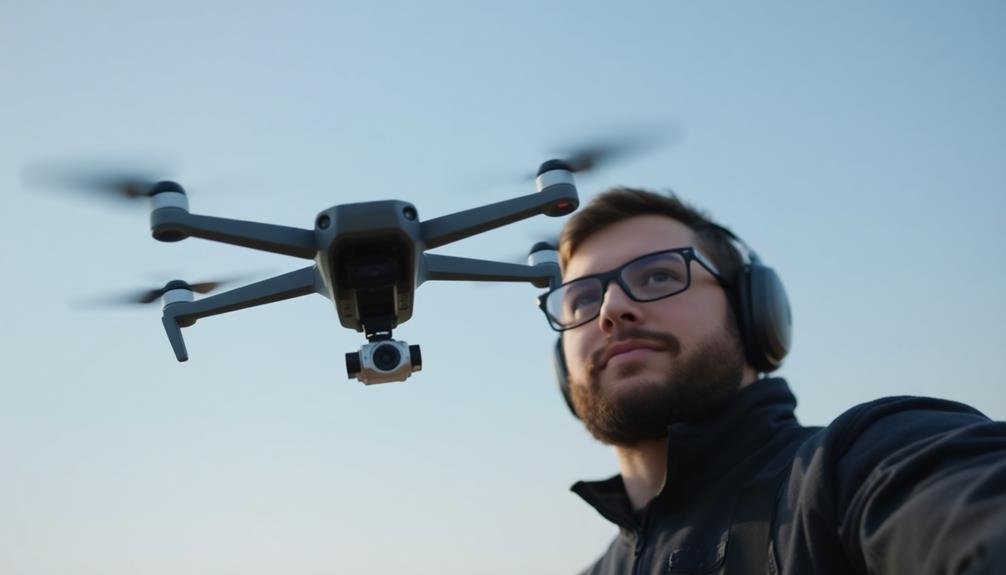
As a visual observer for drone photography, your primary responsibility is to maintain a clear visual line of sight with the aircraft at all times. This means you must be able to see the drone without the aid of any device other than corrective lenses.
You'll need to position yourself in a way that allows for unobstructed views of the drone and its surrounding airspace.
It's essential to stay vigilant and track the drone's movements continuously. You'll need to be aware of potential obstacles, such as trees, buildings, or other aircraft, that could interfere with the drone's flight path.
Communication with the pilot is key – you must be able to relay information about the drone's position, orientation, and any potential hazards quickly and accurately.
Scan for Airborne Hazards

While maintaining visual line of sight is essential, your role as a visual observer extends beyond just tracking the drone.
You're responsible for scanning the surrounding airspace for potential hazards that could pose a risk to the drone or other aircraft. This task requires constant vigilance and a keen eye for detail.
As you scan the sky, you'll need to look out for various airborne hazards.
Here's what you should be watching for:
- Other aircraft, including planes, helicopters, and other drones
- Birds, especially large ones that could collide with the drone
- Weather changes, such as approaching storms or sudden wind gusts
- Obstacles like trees, power lines, or tall buildings that weren't initially visible
Monitor Weather Conditions
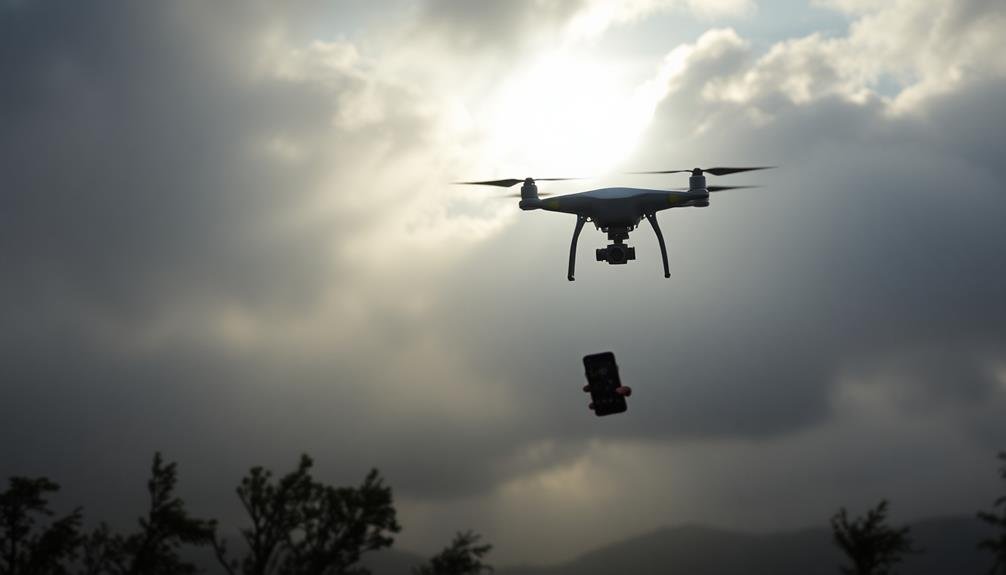
Weather conditions can change rapidly, affecting drone flight safety and image quality. As a visual observer, you're responsible for continuously monitoring the weather throughout the flight.
Keep an eye on wind speed and direction, as strong gusts can push the drone off course or make it difficult to control. Watch for sudden changes in cloud cover, which can affect lighting conditions and visibility.
You'll need to be aware of temperature fluctuations, as extreme heat or cold can impact battery performance and flight time. Monitor humidity levels, as high moisture content can lead to condensation on the camera lens or other sensitive equipment.
Be alert for approaching storm systems, including rain, lightning, or hail, which pose significant risks to the drone and operator.
Pay attention to visibility changes caused by fog, haze, or smoke. These conditions can impair your ability to maintain visual line of sight with the drone.
Use weather apps and local forecasts to anticipate potential changes, but always trust your own observations over predictions. If conditions deteriorate, communicate with the pilot to determine whether it's necessary to abort the flight for safety reasons.
Communicate Clearly With Pilot
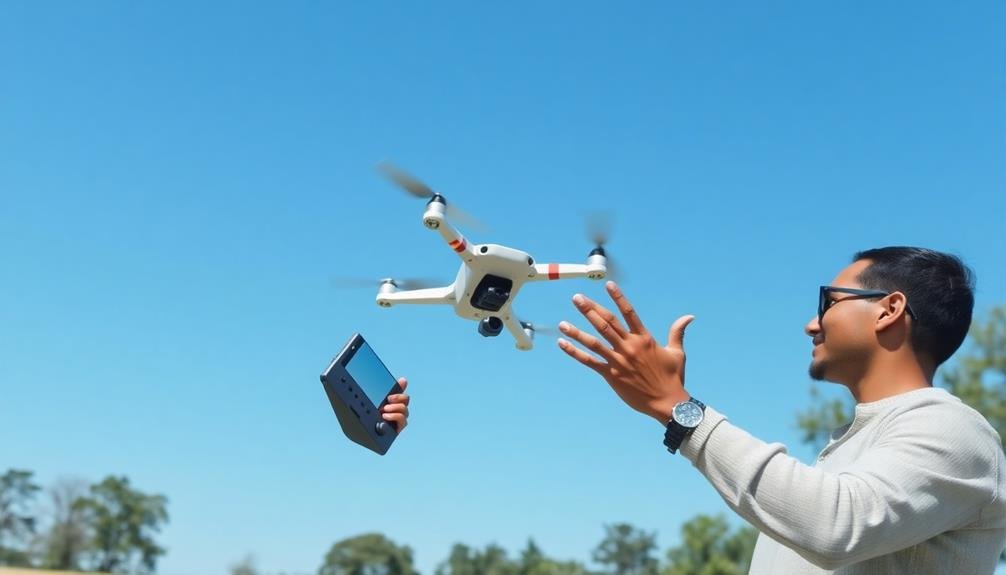
Establishing clear communication with the pilot is essential for safe and effective drone operations. As a visual observer, you're the pilot's extra set of eyes, and your ability to relay information quickly and accurately can make a significant difference in the mission's success and safety.
To guarantee effective communication:
- Agree on a set of clear, concise verbal commands before the flight.
- Use a reliable communication system, such as two-way radios or headsets.
- Practice proper radio etiquette, speaking clearly and avoiding unnecessary chatter.
- Confirm that messages are received and understood by the pilot.
When communicating with the pilot, be specific about what you see. Don't just say "obstacle ahead" – specify the type, size, and location of the obstacle. For example, "Large tree, 50 feet ahead, slightly to the right."
If you notice any changes in weather conditions, aircraft performance, or potential hazards, inform the pilot immediately.
Understand Airspace Restrictions
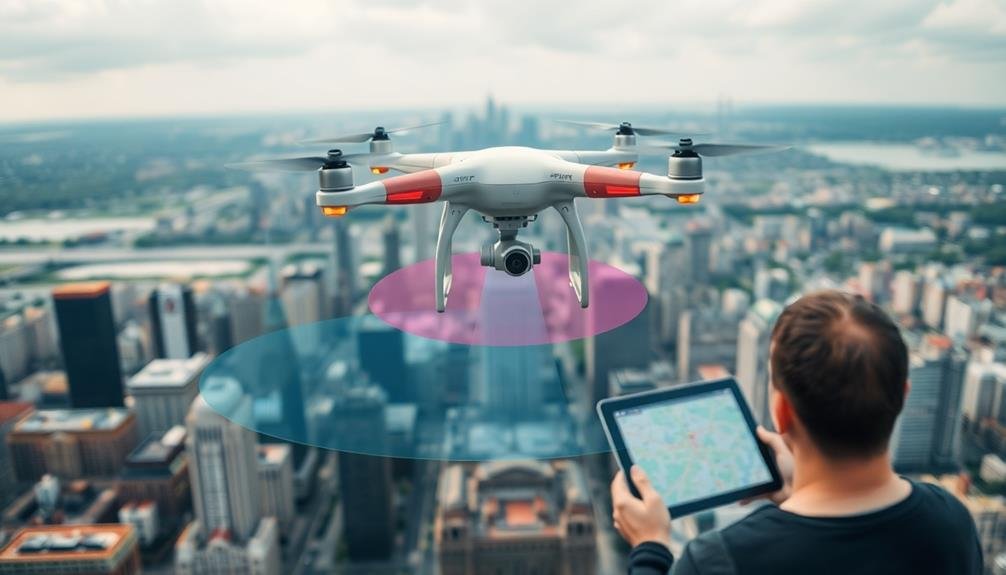
Knowledge of airspace restrictions is essential for any visual observer working with drones. You'll need to familiarize yourself with the different airspace classes and their specific regulations.
Class G airspace, which is uncontrolled, typically allows drone operations without special permission. However, you must be aware of temporary flight restrictions (TFRs) that may be in effect.
For operations in controlled airspace (Classes B, C, D, and E), you'll need to obtain authorization through the LAANC system or by submitting a manual request to the FAA. Be mindful of no-fly zones around airports, military bases, and other sensitive areas.
You should also understand altitude restrictions, which generally limit drone flights to 400 feet above ground level.
As a visual observer, it's your responsibility to help the pilot identify potential airspace violations. Use apps and resources provided by the FAA to check airspace status before and during flights.
Stay updated on local regulations, as some areas may have additional restrictions. By thoroughly understanding airspace rules, you'll contribute to safer drone operations and help avoid potential legal issues for your team.
Identify Safe Landing Areas
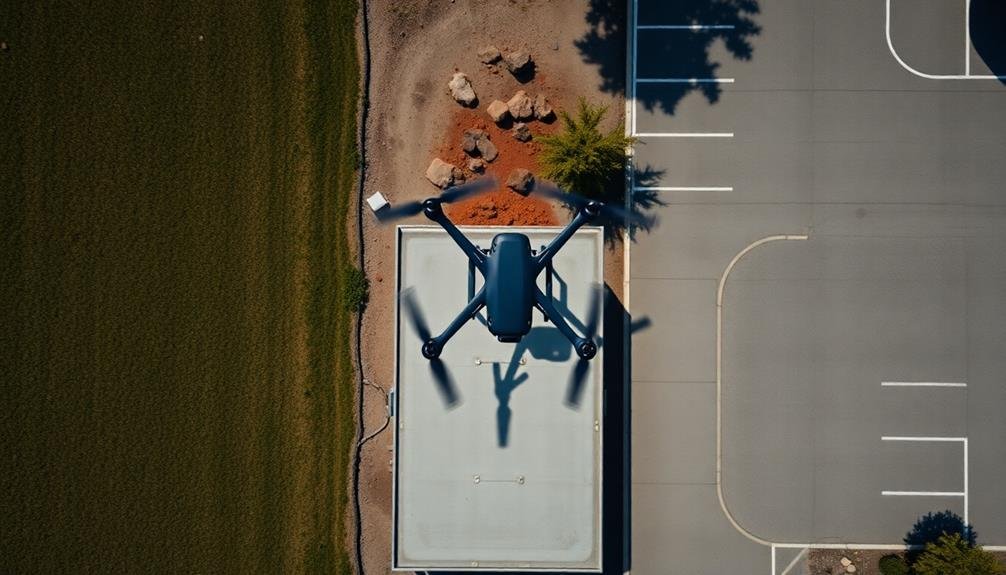
When identifying safe landing areas for your drone, you'll need to carefully assess the terrain and potential obstacles in your surroundings.
Consider emergency situations that might require an immediate landing, such as sudden weather changes or technical malfunctions.
It's essential to pre-plan multiple landing options before takeoff, ensuring you're prepared for various scenarios during your flight.
Assess Terrain and Obstacles
Before launching your drone, carefully survey the surrounding area to identify safe landing spots. Evaluating terrain and obstacles is essential for ensuring a safe flight and protecting your equipment. You'll need to review the landscape, structures, and potential hazards that could interfere with your drone's operation or pose risks during landing.
Start by scanning the immediate vicinity for flat, open areas free from obstructions. Look for:
- Smooth surfaces like concrete, asphalt, or short grass
- Areas clear of trees, power lines, and tall structures
- Spots away from water bodies or steep slopes
- Locations with minimal foot or vehicle traffic
Consider the terrain's stability and composition. Avoid loose gravel, sand, or muddy areas that could damage your drone's components upon landing. Be mindful of changing weather conditions that might affect the terrain, such as rain or wind.
As you evaluate obstacles, pay attention to both static and dynamic elements. Static obstacles include buildings, towers, and natural formations, while dynamic obstacles encompass moving vehicles, people, and animals. Factor in the drone's height and flight path when considering potential collisions or interference with these obstacles.
Remember to reassess the terrain and obstacles throughout your flight, as conditions may change rapidly.
Consider Emergency Situations
As a visual observer, it is crucial to identify safe landing areas for emergency situations before and during your drone flight. Scan the area for potential landing spots that are clear of obstacles, people, and sensitive structures. Look for flat, open spaces like fields, parking lots, or wide paths.
During the flight, keep these areas in mind and continuously reassess their suitability as conditions change. Consider factors such as wind direction, terrain slope, and surface texture when evaluating landing spots. You'll need to quickly communicate these options to the pilot if an emergency arises.
| Emergency Type | Primary Consideration | Secondary Consideration |
|---|---|---|
| Low Battery | Closest safe area | Ease of retrieval |
| Loss of Control | Least populated area | Minimal property damage |
| Weather Change | Sheltered location | Accessibility for pickup |
| Technical Issue | Firm, level surface | Away from water/hazards |
| Airspace Breach | Immediate landing spot | Outside restricted zone |
Be prepared to guide the pilot to the nearest safe landing area in case of equipment failure, sudden weather changes, or airspace violations. Your quick thinking and clear communication can prevent accidents and protect people and property on the ground.
Pre-Plan Multiple Options
Three key steps will help you pre-plan multiple safe landing options for your drone.
First, study your flight area thoroughly using satellite imagery and topographic maps. Identify potential landing zones that are clear of obstacles, people, and sensitive areas.
Second, conduct an on-site inspection before your flight to verify the suitability of these locations and identify any new options or hazards.
Finally, prioritize your landing options based on factors such as:
- Distance from your planned flight path
- Accessibility for retrieval
- Surface conditions (flat, dry, and free of debris)
- Proximity to power lines, trees, or other obstacles
During your pre-flight briefing, communicate these options to your visual observer and other team members. Assign each landing zone a code name or number for quick reference during an emergency.
Remember that weather conditions can change rapidly, so always reassess your options throughout the flight.
Watch for Ground-Based Obstacles
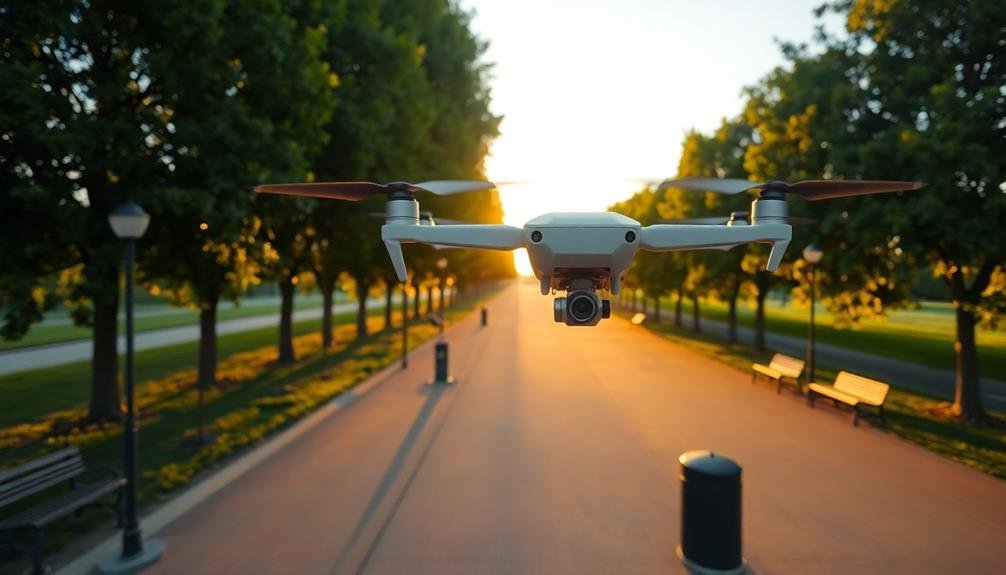
Visual observers must remain vigilant for ground-based obstacles while monitoring drone flights. You'll need to scan the area for potential hazards that could interfere with the drone's operation or pose risks to people and property. Look out for tall structures, trees, power lines, and other elevated objects that may not be visible to the drone pilot.
Pay close attention to moving obstacles like vehicles, pedestrians, or animals that could suddenly enter the flight path. You're responsible for alerting the pilot to any potential dangers, so maintain clear communication throughout the flight.
Here's a quick reference guide for common ground-based obstacles:
| Obstacle Type | Potential Risks | Mitigation Strategies |
|---|---|---|
| Buildings | Collision, signal interference | Maintain safe distance, adjust flight path |
| Trees | Entanglement, visual obstruction | Plan routes around dense foliage |
| Power lines | Electrocution, crash hazard | Identify and avoid, fly above if necessary |
| Vehicles | Sudden movement, distraction | Monitor traffic patterns, adjust altitude |
| People | Privacy concerns, safety risks | Maintain buffer zone, obtain permissions |
Assist With Pre-Flight Checklist
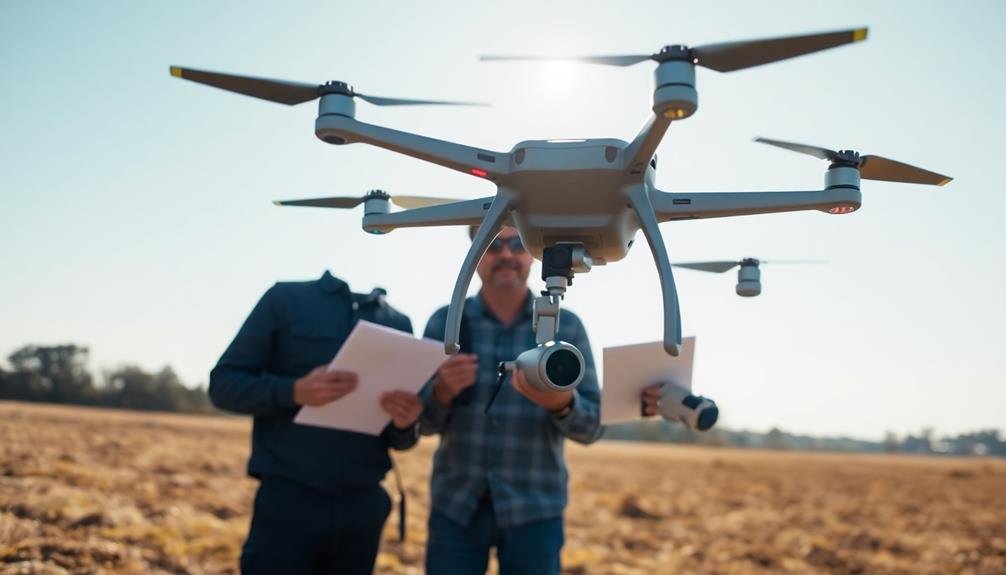
As a visual observer, you'll play an essential role in the pre-flight checklist.
You'll need to verify the functionality of all equipment, including the drone's batteries, cameras, and control systems.
Additionally, you're responsible for evaluating potential environmental hazards like wind conditions, nearby structures, or wildlife that could interfere with the flight.
Equipment Functionality Verification
Safety and reliability hinge on thorough equipment checks before takeoff. As a visual observer, you'll play an essential role in verifying the functionality of all equipment. Work closely with the pilot to guarantee every component is in working order. You'll need to inspect the drone's physical condition, including propellers, motors, and body for any signs of damage or wear.
Next, focus on the key electronic components:
- Battery: Check charge levels and secure attachment
- Remote control: Verify signal strength and responsiveness
- Camera: Test image quality and gimbal movement
- GPS: Confirm satellite lock and positioning accuracy
Don't forget to assess environmental factors that may affect equipment performance. Wind speed, temperature, and humidity can all impact drone operation. You'll need to communicate any concerns to the pilot immediately.
Pay attention to the drone's telemetry data during pre-flight checks. Verify all sensors are calibrated and reporting accurate information.
If you notice any discrepancies or malfunctions, advise the pilot to postpone the flight until the issue is resolved.
Environmental Hazard Assessment
Conducting a thorough environmental hazard assessment is essential for safe drone operations. As a visual observer, you'll play an important role in identifying potential risks before and during the flight.
Start by scanning the area for obvious obstacles like trees, power lines, and tall structures. Don't forget to look for less visible hazards such as thin wires or antennas that might be difficult to spot from the ground.
Pay close attention to weather conditions. Check for strong winds, approaching storms, or sudden changes in temperature that could affect the drone's performance.
Be aware of the sun's position, as glare can interfere with the pilot's ability to see the drone or the camera feed.
Consider the presence of people, animals, or vehicles in the area. Identify potential landing zones in case of an emergency.
Look for signs of radio interference that might disrupt the drone's control signals. If you're operating near water, assess the risks of flying over it and plan accordingly.
Track Flight Time and Battery
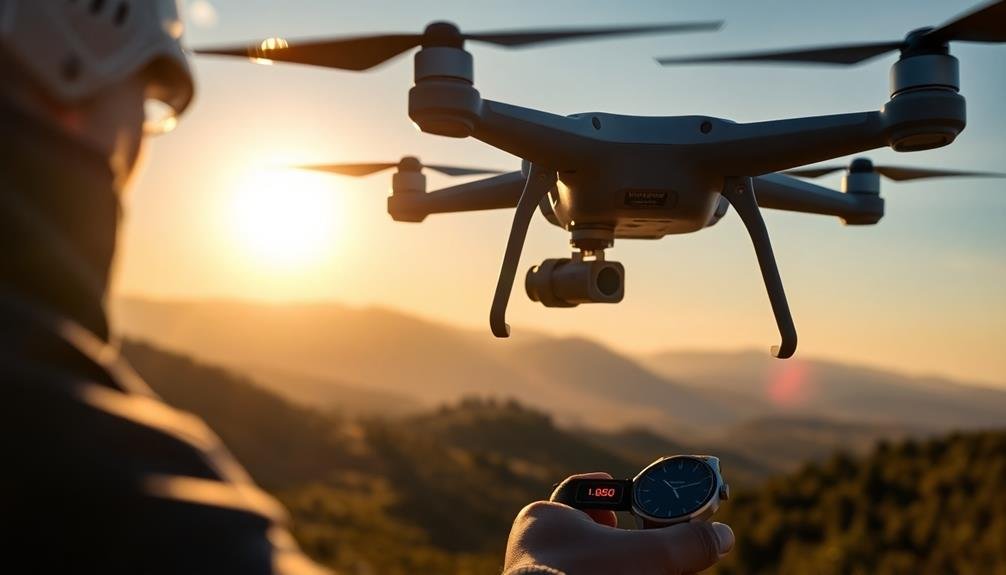
Drone flight-time management is vital for safe and successful aerial photography. As a visual observer, you're responsible for helping the pilot track flight time and monitor battery levels. Most consumer drones have limited flight times, typically ranging from 20 to 30 minutes. It's important to keep a close eye on these factors to prevent unexpected landings or crashes.
To effectively track flight time and battery levels:
- Use a timer or stopwatch to monitor the duration of each flight.
- Familiarize yourself with the drone's battery life and performance characteristics.
- Communicate regularly with the pilot about remaining flight time and battery percentage.
- Plan for a safe return with at least 25% battery life remaining.
Stay vigilant and alert the pilot when it's time to bring the drone back.
Remember that factors like wind speed, temperature, and payload can affect battery life. If you notice any sudden drops in battery levels or unusual behavior, advise the pilot to land immediately.
Be Aware of Privacy Concerns

While capturing stunning aerial shots is exciting, you must always be mindful of privacy concerns when operating a drone. Respect people's right to privacy by avoiding flying over private property without permission.
Don't hover near windows, backyards, or other areas where individuals have a reasonable expectation of privacy. If you're photographing in residential areas, be extra cautious and considerate of the residents' privacy.
Be aware of local laws and regulations regarding drone photography, as some areas may have stricter privacy rules. Avoid capturing images of identifiable individuals without their consent, especially in private settings.
If you accidentally capture such footage, delete it immediately. When shooting in public spaces, focus on landscapes and general scenes rather than specific people.
Always inform nearby individuals that you're operating a drone and explain your purpose. This transparency can help alleviate concerns and prevent misunderstandings.
If someone objects to your drone's presence, respect their wishes and move to a different location. Remember, responsible drone operation includes protecting others' privacy rights while pursuing your creative vision.
Frequently Asked Questions
How Do I Become Certified as a Visual Observer for Drone Operations?
To become a certified visual observer for drone operations, you'll need to complete a training course, pass an exam, and gain practical experience. Contact your local aviation authority or drone organizations for specific certification requirements in your area.
What Are the Legal Consequences of Failing to Follow Visual Observer Rules?
You'll face potential fines, license suspension, or even criminal charges for ignoring visual observer rules. It's essential you follow regulations to guarantee safety and legal compliance during drone operations. Don't risk severe consequences by cutting corners.
Can a Visual Observer Also Act as the Remote Pilot Simultaneously?
You can't be both the visual observer and remote pilot simultaneously. These are separate roles with distinct responsibilities. You'll need to choose one or the other to guarantee safe and compliant drone operations.
Are There Age Restrictions for Becoming a Visual Observer for Drones?
You'll find no specific age restrictions for visual observers in FAA regulations. However, you should be mature enough to effectively assist the remote pilot. It's recommended that you're at least 16 years old for this role.
How Far Can a Visual Observer Be Positioned From the Drone Operator?
You can be positioned at any distance from the drone operator as long as you're able to maintain visual line-of-sight with the drone and effectively communicate with the pilot throughout the entire flight operation.
In Summary
You've now learned the vital rules for being a drone visual observer in photography. By following these guidelines, you'll help guarantee safe and legal flights while capturing amazing aerial shots. Remember, your role is essential for maintaining situational awareness and supporting the pilot. Stay vigilant, communicate effectively, and always prioritize safety. With practice, you'll become an invaluable part of any drone photography team. Keep these rules in mind for successful flights and stunning images.

As educators and advocates for responsible drone use, we’re committed to sharing our knowledge and expertise with aspiring aerial photographers.




Leave a Reply